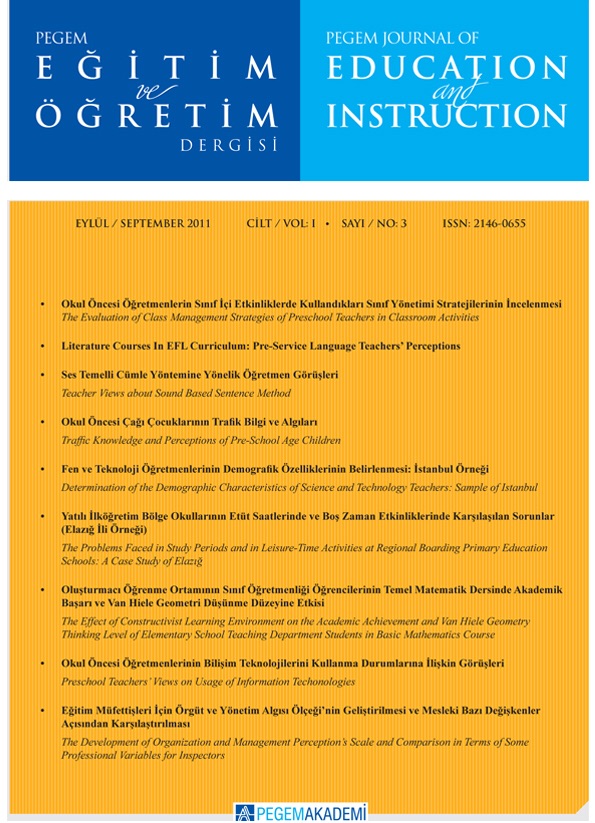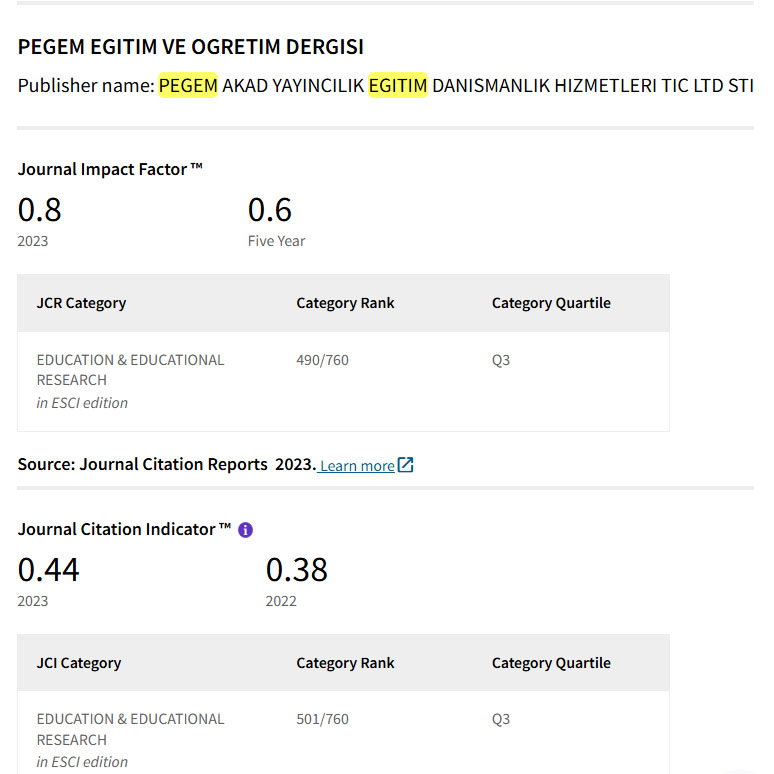Teacher views about sound based sentence method
DOI:
https://doi.org/10.14527/C1S3M3Abstract
In this research aims to determine their views the teacher about "training sequence of letters", "syllable, word, sentence and text production in the first group stage of the implementation of " and the "technique to reach the open syllable" in sound based sentence method. For this purpose, working in the province of Usak semi-structured interview administered to 123 classroom teachers. In data analysis, descriptive analysis technique was used. Teachers participating in the research, education regarding the order of the letters was not a majör problem but the last groups of the p, ç, h, f and s letters, bringing the first syllable and Word derivation in the letters indicated that increase efficiency. The majority of teachers who participated in the survey make it more difficult to read fluently and should be replaced by an new technique to reach the open syllable. In addition, the first group, the syllable, word, sentence and text production practices in the administration stated that pose no problem.
Downloads
References
Akyol, H. (2005). İlkokuma-yazma programı ve öğretimi. Eğitimde yeni yansımalar VII. Yeni İlköğretim Programlarını Değerlendirme Sempozyumu. Erciyes Üniversitesi, Kayseri.
Alver M. ve Durukan E. (2008). Ses Temelli Cümle Yönteminin öğretmen görüşlerine göre değerlendirilmesi. Uluslararası Sosyal Araştırmalar Dergisi The Journal of International Social Research, 1(5).
Amudson S. J. (2001). Prewriting and handwriting skills. Case-Smith J. Occupational Therapy for Children (4th.Ed.). St. Louis, Missouri: Mosby.
Bay, Y. (2010). Ses temelli cümle yöntemiyle ilk okuma-yazma öğretiminin değerlendirilmesi. Kuramsal Eğitimbilim, 3 (1), 164-181.
Çelenk, S. (2007). İlkokuma-yazma öğretimi. Ankara: Maya Akademi Yayın Dağıtım.
Demirel, M. (2006). İlkokuma yazma öğretimindeki değişiklikler üzerine bir araştırma (Yayınlanmamış yüksek lisans tezi) Selçuk Üniversitesi Sosyal Bilimler Enstitüsü, Konya.
Dikmen, S. (1998). İlkokuma yazma öğretmen rehberi. Ankara: Öğretmen Kitapları Dizisi 1.
Güneş, F. (2007). Ses temelli cümle yöntemi ve zihinsel yapılandırma. Ankara: Nobel Yayın Dağıtım.
Hamacheck, D. E. (1979). Psychology in teaching, learning and growth. Boston: Allyn and Bacon.
Kavcar, C., Sever, S. ve Oğuzkan, F. (2004). Türkçe öğretimi. Ankara: Ergin Yayınları.
MEB. (2009). İlköğretim Türkçe dersi öğretim programı ve kılavuzu. Ankara: Talim ve Terbiye Kurulu Başkanlığı.
Öz, F. (2001). Uygulamalı ilkokuma yazma öğretimi. Ankara: Anı Yayıncılık.
Phelps J., Stempel L. ve Speck G. (1985). The children's handwriting scale: A new diagnastic Tool. Journal of Educational Research, 79 (1).
Schneck, C. M. (1991). Comparison of pencil'grip patterns in first graders with good and poor writing skills. The American Journal of Occupational Therapy, 45 (8).
Şenol, M. (1999). Okuma yazma öğretiminin tasviri bibliyografyası (Yayınlanmamış yüksek lisans tezi) Afyon Kocatepe Üniversitesi Sosyal Bilimler Enstitüsü, Afyon.
Tosunoğlu, M., Tosunoğlu, N. ve Arslan, M. (2008). İlköğretim Türkçe dersi öğretim programına göre yapılan öğretimin ilkokuma yazma becerisi açısından değerlendirilmesi. Ticaret ve Turizm Fakültesi Dergisi, 2, 117-133.
Tseng, M. H. & Cermak, S. A. (1993). The influence of ergonomic factors and perceptual motor abilities on handwriting perfprmance. The American Journal of Occupational Therapy, 47(10).
Turan, M. ve Akpınar, B. (2008). İlköğretim Türkçe Dersi ilkokuma yazma öğretiminde kullanılan ses temelli cümle ve bitişik eğik yazı yöntemlerinin değerlendirilmesi. Fırat Üniversitesi Sosyal Bilimler Dergisi, 1, 121-1.
http://www.2020site.org/writing/penmanship.html Penmanship: A practical system (2011).
Downloads
Published
How to Cite
Issue
Section
License
Attribution — You must give appropriate credit, provide a link to the license, and indicate if changes were made. You may do so in any reasonable manner, but not in any way that suggests the licensor endorses you or your use.
NonCommercial — You may not use the material for commercial purposes.
No additional restrictions — You may not apply legal terms or technological measures that legally restrict others from doing anything the license permits.




